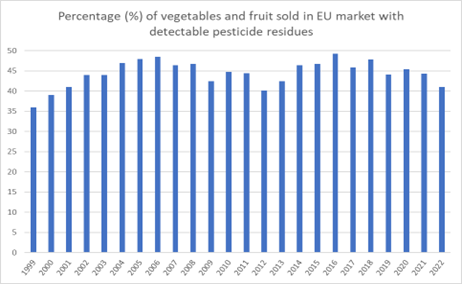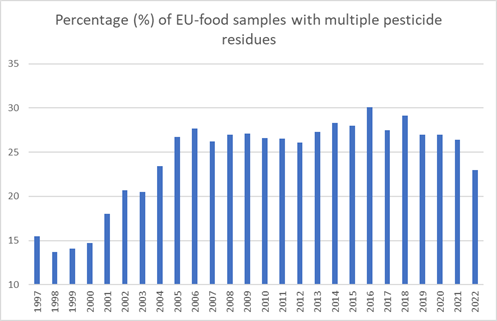A new EFSA report reveals that 41% of European fruit and vegetables contain pesticide residues. In more than half of these cases, consumers are exposed to several pesticide residues at the same time. Cocktail effects are still not taken into account by regulators, while science continues to warn of the obvious risks to human health of such combined exposure.
Today, the European Food Safety Authority (EFSA) published its latest annual report on pesticide residues in food sold in 2022 in the EU market across the 27 Member States. EFSA positively announced that in 96.3% of the samples, the pesticide residues fall ‘within legally permitted levels’. However, PAN Europe warns this is nothing to applaud for. In fact, 41% of these samples contained detectable pesticide residues. 23% of these contained pesticide cocktails (two or more residues), which are currently not regulated, despite the scientific evidence on the potential harm of cocktail effects. Therefore contrary to EFSA’s announcement, these results are far from reassuring.
Salomé Roynel, policy officer at PAN Europe says: ”EFSA's announcements do not tell the whole story. European consumers are daily exposed to multiple pesticide residues in their food. This reality is not taken into account by the EFSA when it sets the allowed Maximum Residue Levels, thus underestimating the risks.”
More and more scientific evidence shows that chronic exposure to pesticides, including through the residues in food, increases the probability of developing chronic diseases. Coronary disease, increase in oxidative stress due to metabolites that potentially lead to an increase in cancer, etc. Some researchers also found that people consuming fruits and vegetables with lower levels of pesticides are less susceptible to developing chronic diseases, suggesting that pesticide residues in food offset the benefits of consuming fruits and vegetables.
For many pesticides, including PFAS and endocrine disrupting substances, the maximum residue levels are far too high. They should basically be 0.
Food without detectable pesticide residues: In 2022 the percentage of vegetables and fruit in European shops with detectable pesticide residues (below the analytical detection limit) went slightly down to 41% compared to 44.3% in 2021. This figure is found when aggregating data of all monitoring programmes (EU MACP and MANCP).

Multiple residues in food still remain high: In 2022, the percentage of multiple residues in fruit and vegetables sold in the EU market was 23% compared to 26.4% in 2021 and 27% in 2020 and 2019. Sweet peppers, table grapes, strawberries, apples, peaches, tomatoes, oranges, lemons, pears, lettuce and mandarins were the food items with the highest multiple residues quantified. Despite the marginal decrease, the highest number of multiple residues found in a sample was in tomatoes where 16 different pesticides were quantified followed by strawberries where 15 different pesticides were quantified.

Consumers unprotected from pesticide mixtures
The EU has, in theory, one of the strictest pesticide legislations in the world. Nevertheless, when it comes to the assessment of pesticides mixtures in food, our policy-makers are turning a blind eye. Although the impact of mixtures of pesticides has been a legal requirement in the EU since 2005, the EFSA is yet to deliver a credible assessment procedure that takes into account mixture effects. All its pilot studies so far are not based on the most recent sensitive toxicity data and include so many assumptions that it is highly questionable whether they can ever be implemented to protect consumers' health.
Our policymakers also refuse to apply a “mixtures assessment factor” to account for the potential adverse combined effects of pesticides. Considering that almost one-quarter of the food sold in the EU market contains such pesticide cocktails, the lack of measures to assess the potential harm of these mixtures is unacceptable.
Contact:
- Salome Roynel salome [at] pan-europe.info, +32 2 318 62 55
- Martin Dermine, martin [at] pan-europe.info, +32 486 32 99 92
